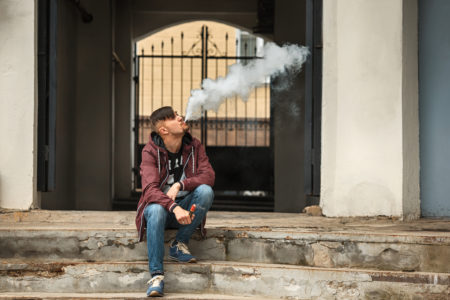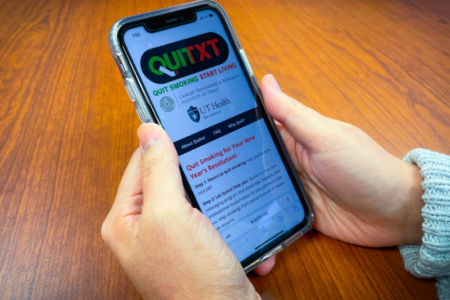
Share On Social!
The CVS Health Foundation, American Heart Association, Alliance for a Healthier Generation have launched a new initiative to help reduce vaping in schools.
The Tobacco-Free Schools Initiative gives schools resources that focus on positive reinforcement for tobacco cessation and prevention, rather than traditional forms of punishment.
Addressing the rise in vaping and e-cigarette use for young people is urgent.
“Youth vaping is one of the biggest obstacles we face in helping to create the first tobacco-free generation,” said Eileen Howard Boone, SVP of Corporate Social Responsibility and Philanthropy, CVS Health and President, CVS Health Foundation, in a press release.
“Coming together with the American Heart Association and Healthier Generation allows us to support schools – who are on the frontlines of the battle against vaping – and give them the tools they need to be even more effective in preventing and addressing tobacco and e-cigarette use among young people,” Boone said.
This new initiative will help support teens and young adults who are struggling with nicotine addiction, especially Latino students who are at higher risk of COVID-19.
What is the Tobacco-Free Schools Initiative?
The Tobacco-Free Schools Initiative centers on supportive environments for tobacco-use cessation.
“The Tobacco-Free District Model Policy and evidence-based resources aim to reinforce supportive learning environments that center tobacco cessation and prevention to improve the health of students,” according to Alliance for a Healthier Generation.
The initiative gives school leaders access to many helpful resources, including:
- The Tobacco-Free District Model Policy that promotes supportive disciplinary practices and alternatives to suspension
- The Tobacco-Free District Assessment that helps districts identify opportunities to update or strengthen their current tobacco policies and practices
- Technical assistance and support to guide leaders in creating sustainable change
- On-demand webinars to help educators grow and sustain a tobacco-free culture of health, and
- Evidence-based strategies and resources.
Why is Addressing Vaping Important?
Although cigarette consumption has decreased in the last few decades, e-cigarette-use and vaping is common among young people.

“While traditional cigarette consumption by youth in the U.S. is at an all-time low (5%), nearly 33% percent of high school students are actively using e-cigarette products and have increased use of menthol and disposable e-cigarettes,” said Nancy Brown, chief executive officer of the American Heart Association, in a press release.
Additionally, young people who vape are extremely susceptible to COVID-19 — about five times more likely than non-vapers, according to a May 2020 research study from Stanford University.
“Young people may believe their age protects them from contracting the virus or that they will not experience symptoms of COVID-19, but the data show this isn’t true among those who vape,” said Dr. Shivani Mathur Gaiha, the study’s lead author and a postdoctoral scholar, in a press release.
Health experts say we must address the rise of vaping and e-cigarettes, but studies show punishment isn’t the right avenue.
Why is a Supportive Environment Better for Tobacco-Use Cessation?
Youth vaping is easier to combat through supportive discipline rather than harsh punishments.
“Current evidence shows that punitive measures, like suspension, do little to curb the use of tobacco products and disproportionally impact students of color,” according to the press release by Healthier Generation and the American Heart Association.
Unfortunately, it’s true. Teachers often treat students of color harsher than white students.
“Children of color are often treated differently by school personnel; they are more likely to be harshly punished for minor infractions, and teachers may underestimate their abilities,” according to a Salud America! research review.

That’s why the Tobacco-Free Schools Initiative wants to create a supportive environment with counseling for students struggling with tobacco use.
“[The initiative’s district model policy] details restorative practices such as education and counseling, in lieu of punitive responses, for tobacco use. It also provides resources that support tobacco-free learning environments, such as assessments and links to school-based curriculums,” according to the press release by Healthier Generation and the American Heart Association.
How Are Latinos Affected by Tobacco-Use?
Latinos are at risk of nicotine addiction from tobacco-use.
While Latino adults do smoke cigarettes at a lower rate (12.1%) than white adults (19.4%), they are more likely to keep smoking and find it harder to quit smoking.
Latinos are also disproportionately affected by COVID-19.
The COVID-19 pandemic has affected Latinos who have worsening health inequities, disparities in exposure, testing, prevention and treatment, and job impact.
This means that Latino children especially must be aware of the risks of vaping and e-cigarettes.
Quit Tobacco with the Great American Smokeout
Do you struggle with tobacco-use? Do you want to quit smoking or vaping?
Today is the Great American Smokeout.
You can join thousands of people who will begin their smoke-free journey with the Great American Smokeout. This annual event from the American Cancer Society encourages smokers to make a plan to stop smoking.
You don’t have to do it alone.

Get support from Quitxt, a free English or Spanish text-message service that turns your phone into a personal “quit smoking” coach from UT Health San Antonio.
To join Quitxt, text “iquit” (for English) or “lodejo” (for Spanish) to 844-332-2058.
“For the Great American Smokeout, we’re excited to share Quitxt to provide real-time help with motivation to quit, setting a quit date, handling stress, and much more, all on your phone,” said Dr. Amelie G. Ramirez, director of the Salud America! program at UT Health San Antonio, and also Quitxt, sponsored by the Cancer Prevention and Research Institute of Texas. “Quitting now can reduce your risk of chronic diseases, cancer, and a severe case of COVID-19.”
Explore More:
Quit SmokingBy The Numbers
142
Percent
Expected rise in Latino cancer cases in coming years



